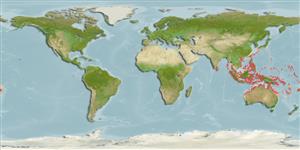>
Gobiiformes (Gobies) >
Gobiidae (Gobies) > Gobiinae
Etymology: Eviota: No etymology given, suggested by Christopher Scharpt: from Latin 'eu' for 'true' and 'iota' for anything very small, in combination 'truly very small' referring to it as being the smallest vertebrate at the time it has benn described by Jenkins (thus, making the suggestion by Scharpt plausible.
More on authors: Lachner & Karnella.
Environment: milieu / climate zone / profondeur / distribution range
Écologie
marin récifal; profondeur 0 - 9 m (Ref. 58018). Tropical
East Indian to Western Pacific: East Andaman Sea (coast of Thailand), Malaysia, Vietnam, Philippines and Palau, Indonesia (Java and Kalimantan to West Papua), and Papua New Guinea.
Taille / Poids / Âge
Maturité: Lm ? range ? - ? cm
Max length : 2.1 cm SL mâle / non sexé; (Ref. 51740)
Description synthétique
Clés d'identification | Morphologie | Morphométrie
Épines dorsales (Total) : 6 - 7; Rayons mous dorsaux (Total) : 8 - 9; Épines anales: 1; Rayons mous anaux: 7 - 8. Characterized by translucent body with internal reddish-brown stripe, white dash-like markings immediately above and similar markings at level of upper pectoral fin base extending to middle of body; cheek with short brown stripe across; snout to occiput with white line on dorsal midline, side of snout with dark stripe; pupil-sized bluish spot at upper pectoral fin base; spots along base of dorsal fin, small and red-brown color; posteroventral body with six short internal brownish bars; longitudinal scale series 23-25; ctenoid scales except on head, nape, breast and base of pectoral fin; separated pelvic fins, bases joins by thin membrane; fourth pelvic ray with 3-8 branches; depth of body 3.9-4.5 in SL (Ref. 90102).
Body shape (shape guide): elongated; Cross section: compressed.
Found in coral reefs, inshore (Ref. 75154).
Life cycle and mating behavior
Maturité | Reproduction | Frai | Œufs | Fécondité | Larves
Lachner, E.A. and S.J. Karnella, 1980. Fishes of the Indo-Pacific genus Eviota with descriptions of eight new species (Teleostei:Gobiidae). Smithson. Contrib. Zool. (315):127 p. (Ref. 5293)
Statut dans la liste rouge de l'IUCN (Ref. 130435: Version 2025-1)
Menace pour l'homme
Harmless
Utilisations par l'homme
Outils
Articles particuliers
Télécharger en XML
Sources Internet
Estimates based on models
Preferred temperature (Réf.
123201): 25.2 - 29.3, mean 28.6 °C (based on 2249 cells).
Phylogenetic diversity index (Réf.
82804): PD
50 = 0.5000 [Uniqueness, from 0.5 = low to 2.0 = high].
Bayesian length-weight: a=0.00692 (0.00284 - 0.01683), b=3.10 (2.92 - 3.28), in cm total length, based on LWR estimates for this Genus-body shape (Ref.
93245).
Niveau trophique (Réf.
69278): 3.1 ±0.3 se; based on size and trophs of closest relatives
Résilience (Réf.
120179): Haut, temps minimum de doublement de population inférieur à 15 mois (Preliminary K or Fecundity.).
Fishing Vulnerability (Ref.
59153): Low vulnerability (10 of 100).
🛈
Nutrients (Ref.
124155): Calcium = 1400 [600, 5,893] mg/100g; Iron = 3.26 [1.37, 8.30] mg/100g; Protein = 16.8 [14.7, 18.7] %; Omega3 = 0.151 [0.041, 0.520] g/100g; Selenium = 46.7 [11.7, 158.1] μg/100g; VitaminA = 31.3 [5.5, 172.1] μg/100g; Zinc = 5.37 [2.83, 9.53] mg/100g (wet weight);
